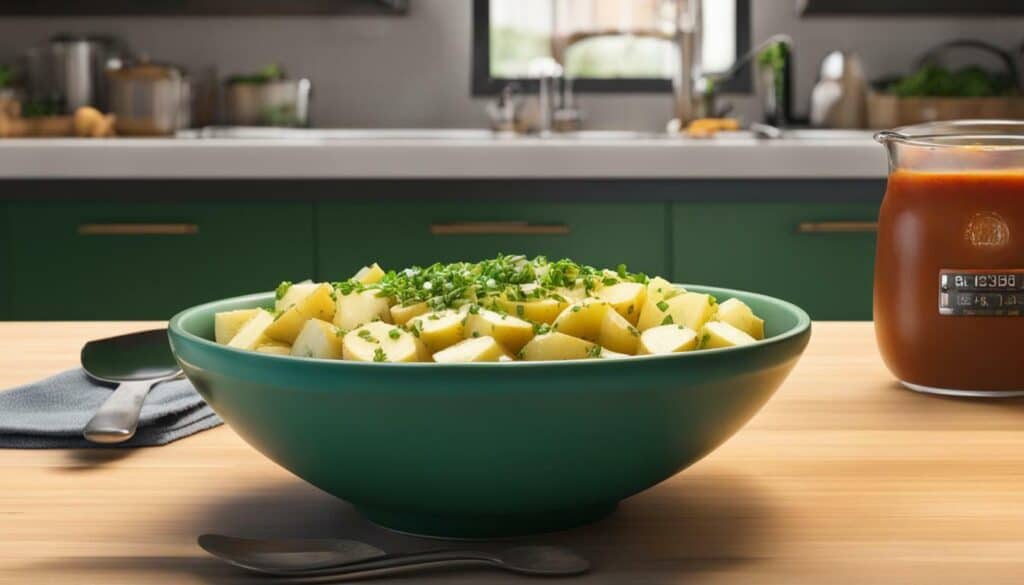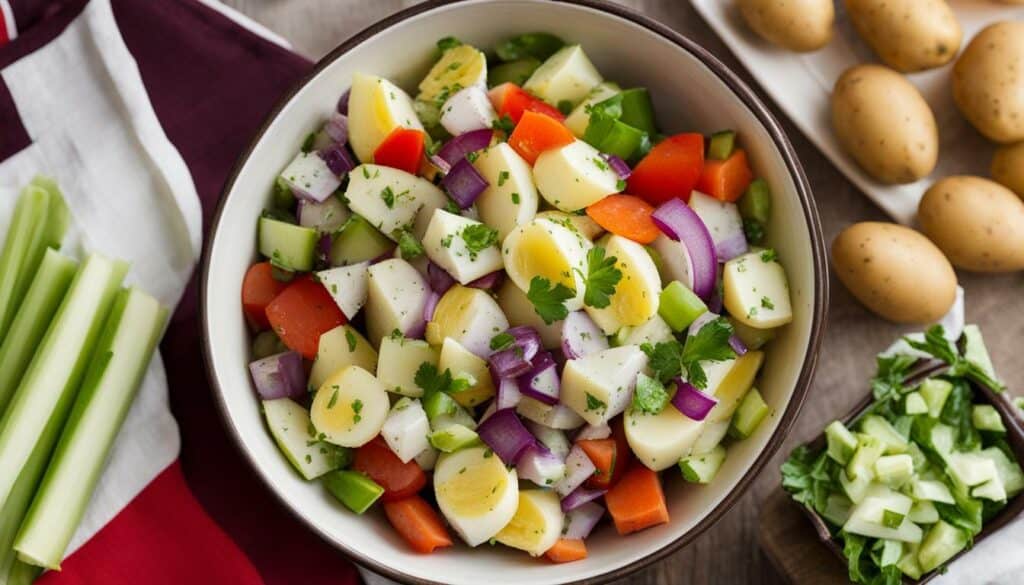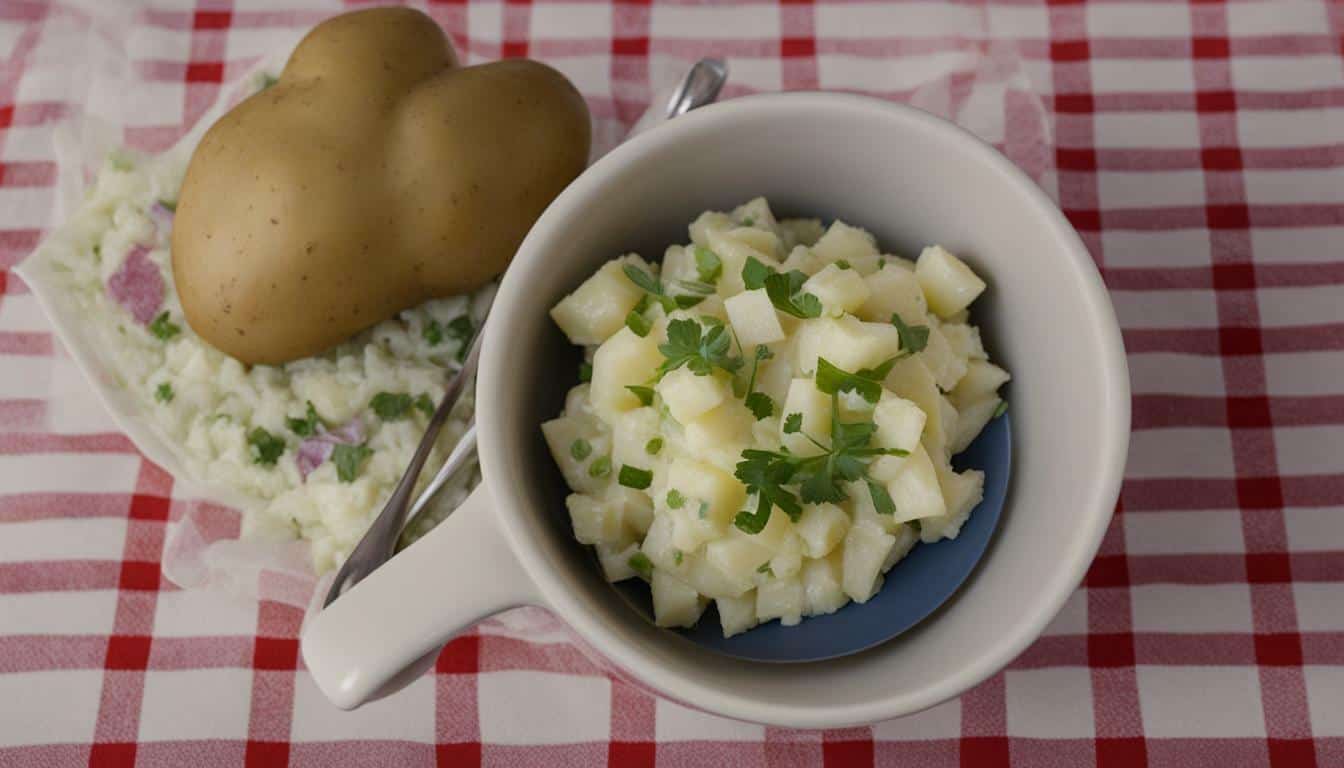Are you curious about the number of calories in a cup of potato salad? Potato salad is a beloved dish that often makes its appearance at picnics, barbecues, and family gatherings. But before indulging in this creamy and flavorful side dish, it’s important to be aware of its calorie content. Understanding the calorie count can help you make informed choices about portion sizes and incorporate potato salad into a well-balanced diet.
- A cup of potato salad contains approximately 358 calories.
- The breakdown of calories in potato salad is 57% fat, 35% carbs, and 8% protein.
- Potato salad offers various vitamins and minerals, including Vitamin A, Vitamin C, Calcium, and Iron.
- Calorie count and nutrient values may vary based on the specific recipe or brand of potato salad.
- Consult a healthcare professional or refer to the nutritional information on the packaging for more accurate details.
Understanding the Nutritional Value of Potato Salad
Potato salad not only tastes delicious, but it also offers a range of nutrients. A cup of potato salad provides approximately 358 calories, making it a satisfying side dish for any meal. Let’s delve into the specific nutritional values and benefits of potato salad.
When it comes to macronutrients, potato salad contains about 57% fat, 35% carbs, and 8% protein. The fat content in a cup of potato salad amounts to 20.5g, while the carbohydrate content is around 27.92g. Additionally, it provides 6.7g of protein. These macronutrients are essential for energy production, muscle repair, and overall bodily function.
Furthermore, potato salad is rich in vitamins and minerals. It contains Vitamin A, which is vital for vision and immune health, as well as Vitamin C, which contributes to a healthy immune system and collagen production. Additionally, potato salad provides Calcium for strong bones and teeth, and Iron for oxygen transportation in the body. These nutrients play a significant role in maintaining overall health and well-being.
It’s important to note that the specific calorie count and nutrient values of potato salad may vary depending on the recipe or brand. To obtain accurate details, it is advisable to consult a healthcare professional or refer to the nutritional information provided on the packaging. By doing so, you can make informed choices about including potato salad in your diet while catering to your nutritional needs and goals.
| Nutrient | Amount |
|---|---|
| Fat | 20.5g |
| Carbohydrates | 27.92g |
| Protein | 6.7g |
Enjoying a delicious cup of potato salad not only satisfies your taste buds but also provides valuable nutrients that contribute to your overall well-being. Remember to consider the specific recipe or brand you choose, as this can affect the calorie count and nutrient values. By making informed choices and paying attention to your dietary needs, you can enjoy the goodness of potato salad while maintaining a balanced and healthy lifestyle.

Remember, the key to a balanced diet is moderation and understanding the nutrient content of the foods you consume. So next time you savor a cup of potato salad, take pleasure in the flavors while appreciating the beneficial vitamins, minerals, and macronutrients it provides.
Unveiling the Calorie Count
Let’s dive into the calorie content of a cup of potato salad and see how it adds up. A cup of potato salad contains approximately 358 calories. However, it’s important to note that the specific recipe or brand of potato salad may slightly alter the calorie count. To get a better understanding of the nutrient composition, let’s break it down further.
The breakdown of calories in potato salad is approximately 57% fat, 35% carbs, and 8% protein. This means that a significant portion of the calorie content comes from fat. In a cup of potato salad, you’ll find around 20.5 grams of fat. While fat is a necessary component of a balanced diet, it’s essential to be mindful of consuming too much saturated or trans fats.
Carbohydrates make up a considerable portion of the calorie count in potato salad. In a cup, you’ll find about 27.92 grams of carbs. Carbs provide energy for the body, but choosing complex carbs found in whole grains or vegetables is generally more beneficial for overall health.
When it comes to protein, potato salad provides a modest amount. In a cup, you’ll get around 6.7 grams of protein. While this may not be a significant source of protein, it still contributes to meeting your daily intake. Protein is essential for various bodily functions, including repairing and building tissues.
| Nutrient | Amount per cup |
|---|---|
| Fat | 20.5g |
| Carbohydrates | 27.92g |
| Protein | 6.7g |
Potato salad is not just about calories; it also provides various vitamins and minerals. A cup of potato salad can offer important nutrients such as Vitamin A, Vitamin C, Calcium, and Iron. These vitamins and minerals are vital for maintaining good health and supporting various bodily functions.
It’s important to keep in mind that the calorie count and nutrient values of potato salad may vary depending on the specific recipe or brand. If you have specific dietary concerns or restrictions, it is always advisable to consult a healthcare professional or refer to the nutritional information provided on the packaging for more accurate details.

The fat content in potato salad plays a significant role in its overall nutritional profile. While fat has long been associated with negative health effects, it’s important to remember that not all fats are created equal. In fact, certain types of fats, like monounsaturated and polyunsaturated fats, are considered healthy and can provide numerous benefits for our bodies.
In a cup of potato salad, the fat content is approximately 20.5g. It’s worth noting that fat is the most calorie-dense macronutrient, containing 9 calories per gram, compared to 4 calories per gram of carbohydrates and protein. This means that even though the fat content may seem high, it’s not necessarily a cause for concern if the majority of the fat comes from healthier sources.
Some common ingredients in potato salad, such as mayonnaise or sour cream, contribute to the fat content. These ingredients are often high in saturated fats, which should be consumed in moderation. However, there are healthier alternatives available, such as using Greek yogurt or avocado in place of mayonnaise. These substitutions can not only reduce the saturated fat content but also provide additional nutrients and a creamy texture.
| Nutrient | Amount Per Cup |
|---|---|
| Fat | 20.5g |
| Carbohydrates | 27.92g |
| Protein | 6.7g |
It’s also important to consider the overall balance of fats in our diet. While potato salad may contain a moderate amount of fat, it can still be enjoyed as part of a healthy and well-rounded eating plan. By being mindful of portion sizes and making conscious choices about the ingredients used, you can create a healthier potato salad that satisfies both your taste buds and your body’s nutritional needs.

To further enhance the nutritional profile of your potato salad, you can opt for healthier fats by incorporating ingredients such as olive oil, nuts, or seeds. These sources of monounsaturated and polyunsaturated fats can provide essential fatty acids and promote heart health. Additionally, you can add a variety of fresh herbs and spices to enhance the flavor profile of your potato salad, reducing the need for excessive amounts of fatty dressings or sauces.
By understanding the role of fat in potato salad and making informed choices about the types and quantities of fats used, you can create a healthier version of this classic dish without sacrificing taste or enjoyment. Remember, moderation and balance are key when it comes to incorporating any food into a nutritious diet.
For more accurate details about the calorie count and nutrient values of specific potato salad recipes or brands, it is advisable to consult a healthcare professional or refer to the nutritional information provided on the packaging.
Analyzing the Carbohydrate Content
Carbohydrates are a key component of potato salad, so let’s take a closer look at their role. A cup of potato salad typically contains 27.92g of carbohydrates. These carbohydrates provide the body with a vital source of energy and play a significant role in maintaining overall health.
Complex carbohydrates found in potato salad, such as those derived from the potatoes themselves, are digested slowly by the body, providing a steady release of energy throughout the day. This can help regulate blood sugar levels and prevent sudden spikes or crashes in energy. Carbohydrates also contribute to a feeling of fullness, which can aid in portion control and prevent overeating.
Potato salad can be a versatile dish, and the type and amount of carbohydrates can vary depending on the recipe. For those looking to create a low-calorie potato salad, choosing smaller potato varieties or substituting some of the potatoes with other low-calorie vegetables, such as cauliflower or zucchini, can be a great option. These alternatives can provide the same texture and flavor while reducing the overall carbohydrate content and calorie count.
To summarize, carbohydrates are an essential component of potato salad, providing energy and satiety. By making smart ingredient choices, it is possible to create a delicious and low-calorie potato salad that suits your dietary preferences and health goals.
| Carbohydrate Content in Potato Salad | Grams |
|---|---|
| Total Carbohydrates | 27.92g |
Assessing the Protein Content.
Protein is an essential nutrient in potato salad, offering various health benefits. It plays a crucial role in building and repairing body tissues, supporting the immune system, and facilitating the production of enzymes and hormones. A cup of potato salad contains approximately 6.7g of protein, contributing to the overall nutritional value of this popular side dish.

When it comes to creating a low-calorie potato salad, it’s important to consider different ingredients to enhance its protein content while keeping it nutritious and delicious. Opting for lean sources of protein, such as grilled chicken breast or Greek yogurt, can help elevate the protein content without significantly increasing the calorie count.
| Protein-Rich Ingredients for Low-Calorie Potato Salad | Grams of Protein per Serving |
|---|---|
| Grilled Chicken Breast (3 oz) | 26g |
| Greek Yogurt (1/4 cup) | 6g |
| Quinoa (1/2 cup) | 4.1g |
Incorporating these protein-rich ingredients into your potato salad not only improves its nutritional profile but also helps increase satiety, keeping you feeling fuller for longer. Remember to adjust the quantities of other ingredients to maintain the desired consistency and flavor of your potato salad while keeping the calorie count in check.
Enhancing Flavor with Herbs and Spices
In addition to boosting protein content, adding a variety of herbs and spices can enhance the flavor profile of your low-calorie potato salad. Consider using fresh herbs like basil, parsley, or dill, as well as spices such as paprika, garlic powder, or cayenne pepper. These ingredients not only provide additional micronutrients but also add depth and complexity to your dish without adding unnecessary calories.
By being mindful of the protein content in your potato salad and incorporating nutritious ingredients, you can create a delicious and healthier version that aligns with your dietary goals while still enjoying this classic dish.
Uncovering Additional Nutrients
Alongside calories, fat, carbs, and protein, potato salad provides a range of beneficial nutrients. It is rich in Vitamin A, which promotes good vision, immune function, and healthy skin. Vitamin C is also present, supporting the immune system and assisting in collagen production for healthier skin and joints.
Potato salad is a good source of calcium, contributing to the maintenance of strong bones and teeth. Iron, another vital mineral found in potato salad, helps transport oxygen throughout the body and prevents fatigue. These vitamins and minerals play important roles in overall health and well-being.
To ensure you’re reaping the full benefits, serve your potato salad alongside other fresh vegetables like leafy greens, cherry tomatoes, and cucumber slices. This will enhance the nutritional value and add fiber to your meal. Remember to choose dressings that are lower in fat and sodium to keep your potato salad as healthy as possible.

Let’s take a closer look at the nutritional breakdown of potato salad. In a cup of potato salad, you can expect to find approximately 358 calories. This includes 20.5g of fat, 27.92g of carbohydrates, and 6.7g of protein.
| Nutrient | Amount per Cup |
|---|---|
| Calories | 358 |
| Fat | 20.5g |
| Carbohydrates | 27.92g |
| Protein | 6.7g |
Keep in mind that these values may vary depending on the specific recipe or brand of potato salad. It’s always a good idea to consult a healthcare professional or refer to the nutritional information provided on the packaging for more accurate details regarding the calorie count and nutrient values.
Variations in Recipe and Brands
It’s crucial to keep in mind that the specific recipe or brand of potato salad can affect its nutritional content. While the average calorie count in a cup of potato salad is around 358 calories, this number can vary depending on the ingredients used and the preparation method. Homemade potato salad recipes often allow for more flexibility and control over the ingredients, making it easier to adjust the calorie count and nutrient composition to suit individual preferences and dietary needs.

When making potato salad at home, you have the option to use lighter ingredients or healthier substitutes to reduce the overall calorie count. For example, you can replace full-fat mayonnaise with a lighter version or even opt for Greek yogurt as a creamy base. Adding more vegetables like cucumbers, bell peppers, or cherry tomatoes can also increase the fiber and nutrient content of the salad while adding freshness and crunch.
Additionally, different brands of pre-packaged potato salad may have varying nutritional values. It’s always advisable to check the packaging for detailed information on calories, fat, carbohydrates, protein, vitamins, and minerals. This will help you make an informed choice based on your specific dietary requirements and health goals.
| Brand | Calories | Fat (g) | Carbohydrates (g) | Protein (g) | Vitamin A (% Daily Value) | Vitamin C (% Daily Value) | Calcium (% Daily Value) | Iron (% Daily Value) |
|---|---|---|---|---|---|---|---|---|
| Brand A | 350 | 19 | 28 | 6 | 2 | 15 | 2 | 4 |
| Brand B | 360 | 22 | 25 | 8 | 4 | 10 | 6 | 2 |
| Brand C | 340 | 17 | 30 | 5 | 2 | 20 | 4 | 6 |
Table: Comparison of nutritional values in different brands of potato salad per cup.
Consult a Healthcare Professional for Accurate Nutritional Information
For more accurate information about the nutritional content of potato salad, it is recommended to consult a healthcare professional or refer to the packaging. While I can provide you with some general details about the calorie count and nutrient values, it’s essential to recognize that these may vary based on the specific recipe or brand of potato salad.
Now, let’s explore the fascinating world of potato salad nutrition facts! A cup of potato salad typically contains approximately 358 calories. However, it’s important to note that this number can vary depending on the ingredients used, such as the type of potatoes, mayonnaise, and additional add-ins like eggs or pickles.
The breakdown of calories in potato salad is roughly 57% fat, 35% carbohydrates, and 8% protein. This means that a significant portion of the calories come from fat, so it’s crucial to be mindful of portion sizes if you’re watching your calorie intake. In a cup of potato salad, you can expect around 20.5 grams of fat, 27.92 grams of carbohydrates, and 6.7 grams of protein.
In addition to providing calories and macronutrients, potato salad also offers various vitamins and minerals. It contains Vitamin A, which supports vision health, Vitamin C, which boosts the immune system, and minerals like Calcium and Iron that are essential for overall well-being.
| Nutrient | Amount per Cup (Approx.) |
|---|---|
| Calories | 358 |
| Fat | 20.5g |
| Carbohydrates | 27.92g |
| Protein | 6.7g |
As mentioned earlier, please remember that these values can vary based on the specific potato salad recipe or brand you choose. It’s always best to consult a healthcare professional or check the packaging for precise details about the calorie count and nutrient values of the potato salad you’re consuming.

Armed with knowledge about the calorie count and nutrient values, you can now make informed choices regarding potato salad. When looking to enjoy a healthier version of this classic dish, there are a few key factors to consider.
- Choose lighter dressings: Opt for dressings that are lower in fat and calories, such as a vinegar-based dressing or a light yogurt-based dressing. These alternatives can provide flavor without adding excessive calories.
- Incorporate more vegetables: Add an array of colorful vegetables to your potato salad to boost its nutritional value. Bell peppers, cucumbers, cherry tomatoes, and red onions are great options that can provide additional vitamins and minerals.
- Swap traditional potatoes: Consider using sweet potatoes or cauliflower as a base instead of traditional white potatoes. These alternatives offer lower calorie and carbohydrate content while still providing a satisfying texture.
- Control portion sizes: While potato salad can be a delicious side dish, it’s essential to manage portion sizes. Stick to one cup serving to keep calorie intake in check.
Remember, customization is key. Feel free to experiment with different ingredients and flavor combinations to tailor the potato salad to your liking. Whether you’re looking to reduce calories, increase protein, or add more vegetables, there are endless possibilities to create a potato salad that meets your health goals.
Delicious and Healthier Potato Salad Recipe
“I love this recipe because it combines the creaminess of Greek yogurt with the freshness of herbs and vegetables. It’s a perfect balance of flavors and textures, and most importantly, it’s guilt-free!” – Sarah, Potato Salad Enthusiast
| Ingredients | Amount |
|---|---|
| Potatoes (boiled and cubed) | 2 cups |
| Plain Greek yogurt | 1/2 cup |
| Red onion (finely chopped) | 1/4 cup |
| Celery (chopped) | 1/4 cup |
| Green onions (sliced) | 2 tablespoons |
| Fresh dill (chopped) | 1 tablespoon |
| Fresh parsley (chopped) | 1 tablespoon |
| Lemon juice | 1 tablespoon |
| Salt and pepper | To taste |
Instructions:
- In a large mixing bowl, combine the boiled and cubed potatoes, red onion, celery, green onions, fresh dill, and parsley.
- In a small bowl, whisk together the Greek yogurt, lemon juice, salt, and pepper.
- Pour the yogurt mixture over the potato mixture and gently toss until well coated.
- Refrigerate for at least 30 minutes to allow the flavors to meld together.
- Serve chilled and enjoy!
This lighter potato salad recipe provides a satisfying blend of flavors while keeping the calorie count and fat content in check. It’s perfect for picnics, barbecues, or as a refreshing side dish any time of the year.

Want to enjoy potato salad while keeping the calorie count in check? Here are some ideas for a healthier version.
1. Swap Mayonnaise for Greek Yogurt: Traditional potato salad recipes often call for mayonnaise, which can be high in calories and fat. Instead, try using Greek yogurt as a healthier alternative. Greek yogurt is lower in fat and calories, but still provides a creamy texture and tangy flavor. Simply mix it with some Dijon mustard and a splash of lemon juice for a delicious dressing that complements the potatoes perfectly.
2. Load Up on Vegetables: Add a variety of colorful vegetables to your potato salad to increase its nutritional value. Try incorporating diced bell peppers, cherry tomatoes, cucumbers, and red onions for a refreshing crunch and added vitamins. Not only will this boost the fiber content of the salad, but it will also introduce a range of flavors and textures, making your potato salad more interesting and satisfying.
| Ingredient | Quantity |
|---|---|
| Potatoes | 4 medium-sized |
| Greek Yogurt | 1/2 cup |
| Dijon Mustard | 1 tablespoon |
| Lemon Juice | 1 tablespoon |
| Bell Peppers | 1/2 cup, diced |
| Cherry Tomatoes | 1/2 cup, halved |
| Cucumbers | 1/2 cup, diced |
| Red Onions | 1/4 cup, finely chopped |
3. Swap Regular Potatoes for Sweet Potatoes: Consider using sweet potatoes instead of regular white potatoes for a nutrient-rich twist. Sweet potatoes are lower in calories and have a lower glycemic index, meaning they won’t cause a sharp spike in blood sugar levels. They are also a great source of vitamins A and C, as well as fiber. Simply peel and dice the sweet potatoes, then roast or steam them until tender before adding them to your salad.
With these simple tweaks, you can create a healthier version of potato salad that satisfies your taste buds and supports your health goals. Remember to enjoy it in moderation and be mindful of portion sizes to keep the calorie count in check. So go ahead and indulge in a guilt-free bowl of potato salad!

Potato salad can be a tasty addition to any meal, but it’s essential to be mindful of its calorie count and nutritional composition. A cup of potato salad contains approximately 358 calories, with 57% of those calories coming from fat, 35% from carbohydrates, and 8% from protein. This breakdown translates to about 20.5g of fat, 27.92g of carbohydrates, and 6.7g of protein.
In addition to its calorie content, potato salad also provides various vitamins and minerals, including Vitamin A, Vitamin C, Calcium, and Iron. These nutrients contribute to the overall healthiness of potato salad and can be beneficial for supporting a balanced diet.
It is important to note that the calorie count and nutrient values of potato salad can vary depending on the specific recipe or brand. To obtain more accurate details about the calorie count and nutritional composition, it is advisable to consult a healthcare professional or refer to the nutritional information provided on the packaging. By doing so, you can make informed choices for your dietary preferences and health goals.
Remember, enjoying potato salad can still be a part of a healthy lifestyle when consumed in moderation and balanced with a nutritious overall diet. By being aware of its calorie count and choosing healthier variations or homemade options, you can continue to savor this delicious dish while maintaining a balanced approach to your overall nutrition.
FAQ
Q: How many calories are in a cup of potato salad?
A: A cup of potato salad contains approximately 358 calories.
Q: What is the breakdown of calories in potato salad?
A: Potato salad is composed of 57% fat, 35% carbs, and 8% protein.
Q: How much fat does potato salad contain?
A: A cup of potato salad contains 20.5g of fat.
Q: How many carbs are in potato salad?
A: Potato salad contains 27.92g of carbohydrates.
Q: How much protein is in potato salad?
A: Potato salad provides 6.7g of protein.
Q: What vitamins and minerals are found in potato salad?
A: Potato salad is a source of Vitamins A and C, Calcium, and Iron.
Q: Do the calorie count and nutrient values vary in different potato salad recipes or brands?
A: Yes, the calorie count and nutrient values may vary based on the specific recipe or brand of potato salad. It is advisable to consult a healthcare professional or refer to the nutritional information provided on the packaging for more accurate details.
What is the Calorie Count in Bread with Cheese Snack?
Wondering about the calorie count in bread snacks with cheese? This popular snack can vary depending on the type and quantity of ingredients used. On average, a typical bread with cheese snack can range from 200 to 400 calories. However, it’s always best to check the specific brand, recipe, or packaging information for an accurate understanding of the calorie count in your bread snack with cheese.





Leave a Reply